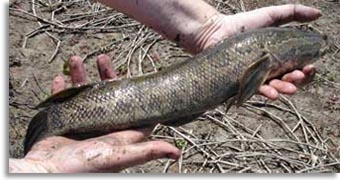|
April 1, 2009
Brinkley, AR – Application of a fish-specific poison to many miles
of creeks and ditches in east Arkansas has been completed in the fight
against the invasive snakehead fish.
Several public agencies, more than a hundred people and three-quarters of a
million dollars are heading up the attack on the ugly and voracious invader
from the Far East that are reproducing in the Pine Creek system in Lee and
Monroe counties, the Arkansas Game and Fish Commission said. If
uncontrolled, AGFC Fisheries chief Mike Armstrong said, the snakeheads
could make a major negative impact on native fish – not immediately but
over the years.
An eradication plan originally scheduled for October last year was
postponed due to heavy rainfall associated with tropical storm systems
Gustav and Ike. The rainfall caused higher-than-normal water flows in Piney
Creek, limiting the AGFC’s ability to effectively implement the eradication
plan. Weather conditions also delayed the rice harvest in many fields
adjacent to Piney Creek, another factor that hampered the eradication
project.
The chemical rotenone was spread in large quantities by land and by air in
the Piney Creek watershed of Monroe and Lee counties. The area is generally
south and east of Brinkley.
The rotenone was spread in powdered form in creeks and ditches by crews in
boats, by personnel riding all-terrain vehicles and by crews in special
tracked vehicles called Marshmasters, brought in by the U.S. Fish and
Wildlife Service. The chemical was also spread in liquid form aerially from
FWS and contract helicopters.
Rotenone is not dangerous to humans, other air-breathing life or to plant
life, the AGFC biologists said.
AGFC officials said the next step is to carefully check the areas where the
rotenone was used to see if any snakeheads remain alive. Joining in the
work were biology students from the University of Central Arkansas under
Dr. Ginny Adams and some volunteers from Arkansas Tech University. They
assisted with picking up dead snakeheads after the rotenone treatment and
will analyze them in laboratory work.
“Hundreds, if not thousands” of dead snakeheads were found after the
rotenone application. An exact count is still underway.

The Arkansas campaign began the use of rotenone on Friday, March 20, on
Piney Creek and its feeder waterways. “We are going after a 49,000-acre
watershed,” Armstrong said. “There are 39 miles of Piney Creek and Little
Piney Creek, and there are 400 miles of ditches leading into these creeks.
That’s a big area.”
AGFC’s fisheries biologists point to a major asset in using rotenone – it
quickly breaks down in the water, rendering it harmless within a few hours.
The chemical is toxic to fish but not to humans and air-breathing animals
and birds. Wind doesn’t carry it to unwanted places, the biologists said.
Working on the eradication effort are more than a hundred people, many from
the Game and Fish Commission but also including U.S. Fish and Wildlife
Service personnel, the college students and some fisheries biologists from
the Tennessee Wildlife Resources Agency. Indiana’s Division of Fish and
Wildlife contributed a sizeable sum toward the purchase of rotenone.
Rotenone is made from the powered roots of some South American plants and
has been used for centuries in Peru to kill fish for human use. Armstrong
said, “There are other sources for poison that that can be used to kill
fish. Green black walnuts, for instance, can be ground up and used the same
way as rotenone. The green walnuts just aren’t as effective as rotenone.”
The campaign to get rid of snakeheads in Piney Creek and its feeder streams
is a harsh one, a total kill.
All fish will be wiped out, Armstrong said. After crews check to see if any
snakeheads remain and none are found, fish will be restocked later this
year. The restocking from AGFC hatcheries will augment natural restocking,
he said. “When there is a void, fish will move in on their own.”
Piney Creek flows into Big Creek in Lee County, and this joins the White
River to the south. Then the White empties into the Mississippi River.
Stopping the snakeheads before they move downstream is an immediate
objective of the campaign, and at the same time, the expectation is for
downstream fish to move into the empty Piney Creek after the rotenone work.
Where did Piney Creek’s snakeheads come from?
They may be the result of escapees from a fish farm near U.S. Highway 79
south of Brinkley. Some years ago the fish farm raised some snakeheads in
response from requests from suppliers to Asian food markets. The fish are
considered delicacies by some Asian people.
The fish farm disposed of its snakeheads in 2001. Arkansas, along with the
rest of the nation, banned snakeheads in 2002, Armstrong said.
About a year ago, a farmer, Russell Bonner, found a strange fish wiggling
across a road on his farm. He took it to AGFC fisheries personnel, who
identified it as a snakehead. More snakeheads were found in a ditch on the
Bonner farm, and others have been found in streams and ditches to the
north. One was found just east of Brinkley, Armstrong said.
A major problem with snakeheads, he explained, is that the “fish are
extremely hardy and very adaptable. They can reproduce five times a year.”
|